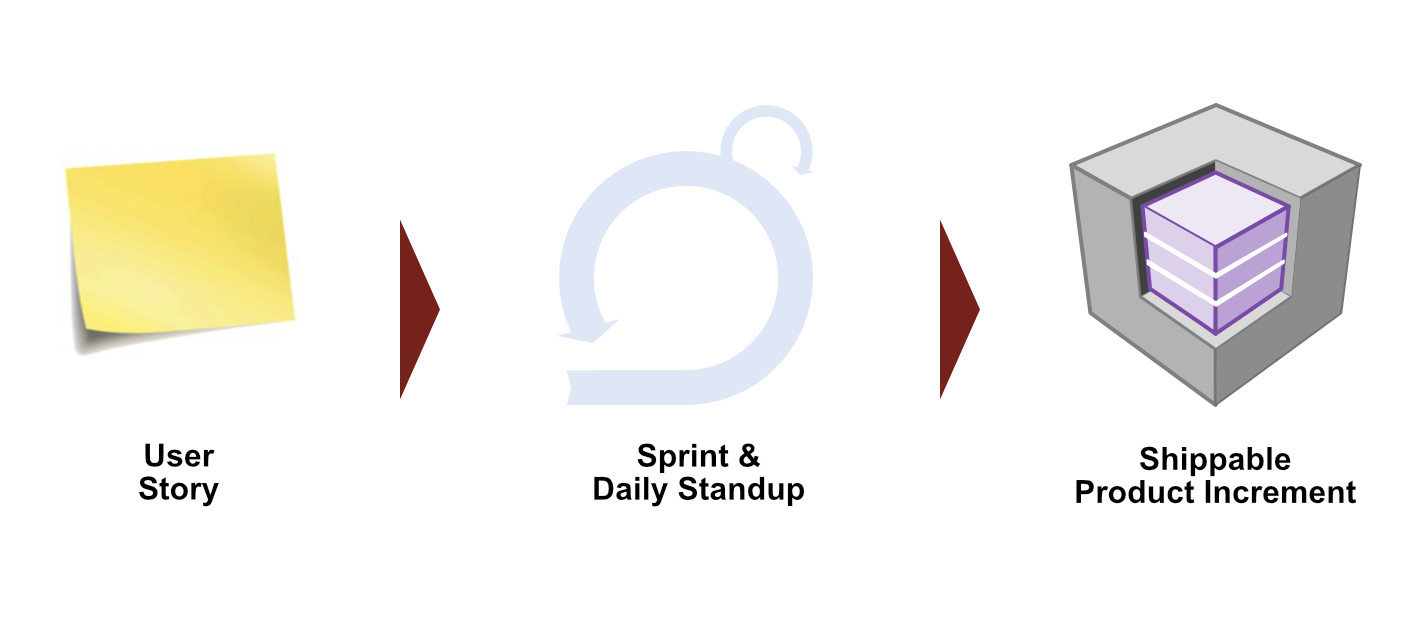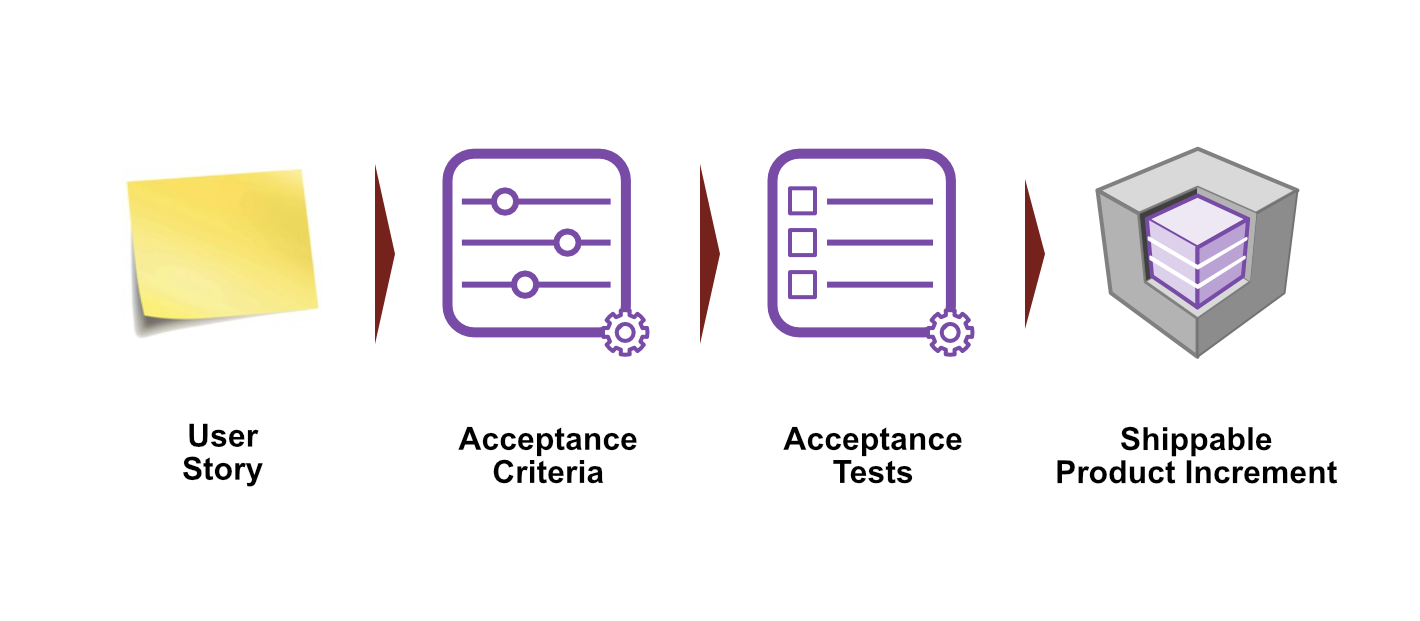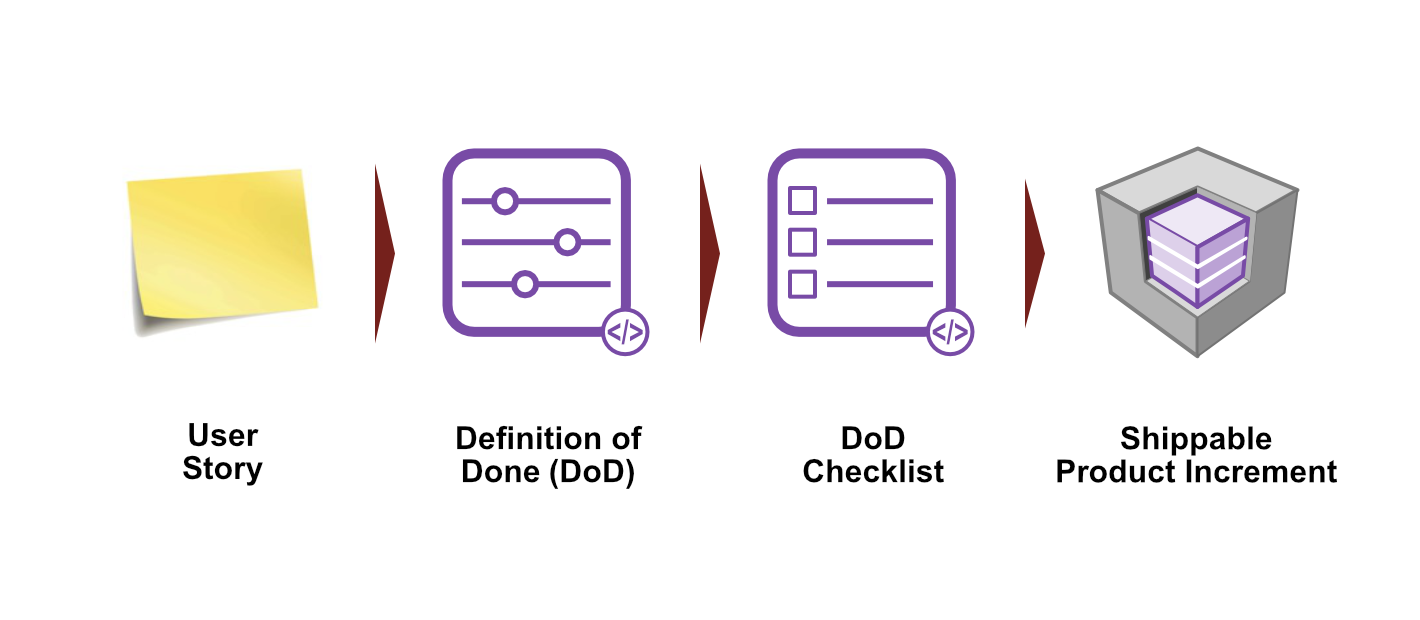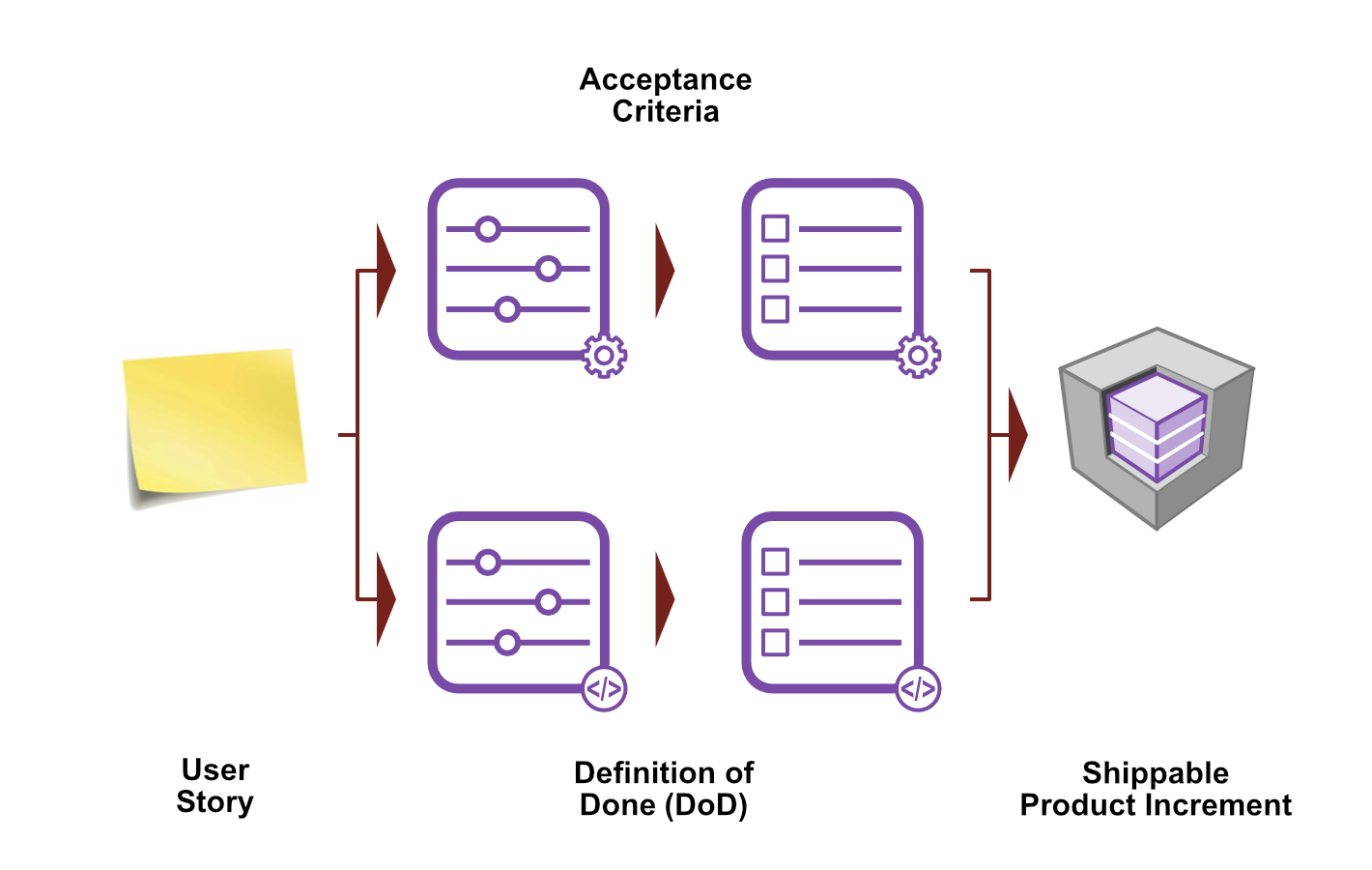Introduction
The Definition of Done (DoD) is a set of criteria that must be met for a task or user story to be considered complete. It includes both technical and business requirements, such as code reviews, testing, user acceptance testing, and stakeholder sign-off. The DoD is agreed upon by the entire team and reviewed regularly to remain relevant.

Without clear Acceptance Criteria and a Definition of Done, teams can easily deliver work that is not aligned with the needs of the customer, resulting in wasted resources, time, and unhappy stakeholders. By having clear Acceptance Criteria and a definition of done in place, teams can consistently deliver high-quality, valuable work that meets the needs of the customer.
What is a Shippable Product Increment?
A shippable product increment is a vital concept in agile software development. It refers to a functional piece of software that is potentially releasable to customers. This means that the product increment should provide value to the user and meet their needs. It is important to note that a shippable product increment is not necessarily a fully-featured or complete product, but it is something that could be released if necessary, even if it is not yet perfect or fully-featured.
To achieve a shippable product increment, the team must adhere to the acceptance criteria and definition of done. The acceptance criteria outlines the specific requirements that the work must meet to be considered done, while the definition of done sets the criteria that must be met for a task or user story to be considered complete. Both of these guidelines are agreed upon by the entire team before starting work, ensuring that everyone has a clear understanding of what is expected.
To achieve a shippable product increment, the team must adhere to the acceptance criteria and definition of done. The acceptance criteria outlines the specific requirements that the work must meet to be considered done, while the definition of done sets the criteria that must be met for a task or user story to be considered complete. Both of these guidelines are agreed upon by the entire team before starting work, ensuring that everyone has a clear understanding of what is expected.

The ability to deliver shippable product increments quickly and frequently is a significant advantage of the agile methodology. By delivering these increments, teams can obtain early feedback from customers, ensuring that the product is meeting their needs and expectations. This feedback can be used to adjust the product roadmap and ensure that the team is delivering high-quality, valuable work that meets the needs of the customer.
It is important to understand that a shippable product increment does not have to be perfect. Perfectionism can lead to delays and lost opportunities. By focusing on delivering functional software that provides value to the user, the team can ensure that they are meeting the needs of the customer while continuing to make improvements in subsequent increments.
A shippable product increment should be potentially releasable, meaning that it should be thoroughly tested and meet the acceptance criteria and definition of done. The increment should also be fully integrated into the existing product, ensuring that it can be seamlessly released to the customer without causing any issues or disruptions.
In conclusion, a shippable product increment is a crucial concept in agile software development. It is a functional piece of software that is potentially releasable to customers, providing value to the user and meeting their needs. To achieve a shippable product increment, the team must adhere to the acceptance criteria and definition of done. By delivering these increments quickly and frequently, the team can obtain early feedback from customers and ensure that they are consistently delivering high-quality, valuable work.
It is important to understand that a shippable product increment does not have to be perfect. Perfectionism can lead to delays and lost opportunities. By focusing on delivering functional software that provides value to the user, the team can ensure that they are meeting the needs of the customer while continuing to make improvements in subsequent increments.
A shippable product increment should be potentially releasable, meaning that it should be thoroughly tested and meet the acceptance criteria and definition of done. The increment should also be fully integrated into the existing product, ensuring that it can be seamlessly released to the customer without causing any issues or disruptions.
In conclusion, a shippable product increment is a crucial concept in agile software development. It is a functional piece of software that is potentially releasable to customers, providing value to the user and meeting their needs. To achieve a shippable product increment, the team must adhere to the acceptance criteria and definition of done. By delivering these increments quickly and frequently, the team can obtain early feedback from customers and ensure that they are consistently delivering high-quality, valuable work.
Acceptance Criteria
Acceptance Criteria are a crucial aspect of agile software development. They are the conditions that must be met for a user story, feature, or task to be considered complete. Acceptance Criteria and Acceptance Tests define the specific requirements that the work must meet to be considered done, ensuring that everyone on the team has a clear understanding of what is expected.
Acceptance Criteria should be specific, measurable, and testable. This means that they should be written in a way that leaves no room for interpretation, ensuring that everyone on the team understands the requirements. Measurable criteria enable the team to measure progress and ensure that the work is on track. Testable criteria enable the team to confirm that the work is functioning as expected and meets the customer's needs.
The process of defining Acceptance Criteria begins with the user story or feature that the team is working on. The team should ensure that they have a clear understanding of the problem that the user story is intended to solve. This understanding helps them to define specific Acceptance Criteria that will meet the customer's needs.
Acceptance Criteria should be specific, measurable, and testable. This means that they should be written in a way that leaves no room for interpretation, ensuring that everyone on the team understands the requirements. Measurable criteria enable the team to measure progress and ensure that the work is on track. Testable criteria enable the team to confirm that the work is functioning as expected and meets the customer's needs.
The process of defining Acceptance Criteria begins with the user story or feature that the team is working on. The team should ensure that they have a clear understanding of the problem that the user story is intended to solve. This understanding helps them to define specific Acceptance Criteria that will meet the customer's needs.

Acceptance Criteria should not only define what the software should do but also what it should not do. This can help ensure that the team is not wasting time on features or functionality that is not necessary or desired.
It is essential that the acceptance criteria are agreed upon by the entire team before work begins. This helps ensure that everyone understands what is expected of them and can work towards a common goal. It can also avoid misunderstandings and ensure that the work is aligned with the customer's needs.
Agile teams often use Acceptance Criteria as a basis for testing. They can use the criteria to create test cases and ensure that the software meets the requirements. This approach can help the team identify issues early in the development process, enabling them to make adjustments before the software is released.
In conclusion, Acceptance Criteria are a critical component of agile software development. They are the conditions that must be met for a user story, feature, or task to be considered complete. Acceptance Criteria define the specific requirements that the work must meet to be considered done, ensuring that everyone on the team has a clear understanding of what is expected. They should be specific, measurable, and testable, agreed upon by the entire team before work begins. By having clear acceptance criteria in place, teams can avoid misunderstandings and ensure that the work they are doing is aligned with the needs of the customer.
It is essential that the acceptance criteria are agreed upon by the entire team before work begins. This helps ensure that everyone understands what is expected of them and can work towards a common goal. It can also avoid misunderstandings and ensure that the work is aligned with the customer's needs.
Agile teams often use Acceptance Criteria as a basis for testing. They can use the criteria to create test cases and ensure that the software meets the requirements. This approach can help the team identify issues early in the development process, enabling them to make adjustments before the software is released.
In conclusion, Acceptance Criteria are a critical component of agile software development. They are the conditions that must be met for a user story, feature, or task to be considered complete. Acceptance Criteria define the specific requirements that the work must meet to be considered done, ensuring that everyone on the team has a clear understanding of what is expected. They should be specific, measurable, and testable, agreed upon by the entire team before work begins. By having clear acceptance criteria in place, teams can avoid misunderstandings and ensure that the work they are doing is aligned with the needs of the customer.
Definition of Done
The definition of done (DoD) is another critical aspect of agile software development. It is a set of criteria that must be met for a task or user story to be considered complete. Unlike acceptance criteria, which are specific to each individual task, the definition of done applies to all work done by the team.
The DoD should be agreed upon by the entire team, including developers, testers, product owners, and stakeholders. It should also be reviewed and updated regularly to ensure that it remains relevant. The DoD should include both technical requirements, such as code reviews and testing, and business requirements, such as user acceptance testing and stakeholder sign-off.
A clear definition of done helps the team ensure that they are consistently delivering high-quality work that meets the needs of the customer. By adhering to the DoD, the team can ensure that they are meeting all requirements, including both technical and business needs. The DoD ensures that the team is not just completing tasks, but completing them in a way that meets the customer's needs and expectations.
The DoD can also help the team identify areas where they can improve their processes. For example, if the DoD requires code reviews but the team is consistently finding issues in code reviews, it may indicate that the team needs to improve their coding practices. By identifying these areas for improvement, the team can continuously improve their processes and deliver higher quality work.
The DoD should be agreed upon by the entire team, including developers, testers, product owners, and stakeholders. It should also be reviewed and updated regularly to ensure that it remains relevant. The DoD should include both technical requirements, such as code reviews and testing, and business requirements, such as user acceptance testing and stakeholder sign-off.
A clear definition of done helps the team ensure that they are consistently delivering high-quality work that meets the needs of the customer. By adhering to the DoD, the team can ensure that they are meeting all requirements, including both technical and business needs. The DoD ensures that the team is not just completing tasks, but completing them in a way that meets the customer's needs and expectations.
The DoD can also help the team identify areas where they can improve their processes. For example, if the DoD requires code reviews but the team is consistently finding issues in code reviews, it may indicate that the team needs to improve their coding practices. By identifying these areas for improvement, the team can continuously improve their processes and deliver higher quality work.

The DoD can be used as a checklist to ensure that all work is completed to the required standard. It should be reviewed regularly to ensure that it remains relevant and up-to-date. As the project progresses, the DoD may need to be updated to reflect changes in the project or to improve the team's processes.
In conclusion, the definition of done is a vital component of agile software development. It is a set of criteria that must be met for a task or user story to be considered complete. The DoD should be agreed upon by the entire team and should be reviewed regularly to ensure that it remains relevant. By having a clear definition of done in place, teams can ensure that they are consistently delivering high-quality work that meets the needs of the customer. The DoD can also be used as a checklist to ensure that all work is completed to the required standard and to identify areas for process improvement.
In conclusion, the definition of done is a vital component of agile software development. It is a set of criteria that must be met for a task or user story to be considered complete. The DoD should be agreed upon by the entire team and should be reviewed regularly to ensure that it remains relevant. By having a clear definition of done in place, teams can ensure that they are consistently delivering high-quality work that meets the needs of the customer. The DoD can also be used as a checklist to ensure that all work is completed to the required standard and to identify areas for process improvement.
Why are Acceptance Criteria and Definition of Done Important?
Acceptance criteria and the definition of done are crucial to the success of agile software development. Without them, teams can easily fall into the trap of delivering work that is not aligned with the needs of the customer. This can lead to wasted time, effort, and resources, and can result in unhappy customers and stakeholders.
Clear acceptance criteria ensure that everyone on the team has a clear understanding of what is expected. This helps the team to avoid misunderstandings and to ensure that they are delivering work that meets the needs of the customer. By adhering to the acceptance criteria, the team can ensure that they are delivering work that meets the customer's expectations and provides value to the user.
Clear acceptance criteria ensure that everyone on the team has a clear understanding of what is expected. This helps the team to avoid misunderstandings and to ensure that they are delivering work that meets the needs of the customer. By adhering to the acceptance criteria, the team can ensure that they are delivering work that meets the customer's expectations and provides value to the user.

The DoD can be used as a checklist to ensure that all work is completed to the required standard. It should be reviewed regularly to ensure that it remains relevant and up-to-date. As the project progresses, the DoD may need to be updated to reflect changes in the project or to improve the team's processes.
In conclusion, the definition of done is a vital component of agile software development. It is a set of criteria that must be met for a task or user story to be considered complete. The DoD should be agreed upon by the entire team and should be reviewed regularly to ensure that it remains relevant. By having a clear definition of done in place, teams can ensure that they are consistently delivering high-quality work that meets the needs of the customer. The DoD can also be used as a checklist to ensure that all work is completed to the required standard and to identify areas for process improvement.
In conclusion, the definition of done is a vital component of agile software development. It is a set of criteria that must be met for a task or user story to be considered complete. The DoD should be agreed upon by the entire team and should be reviewed regularly to ensure that it remains relevant. By having a clear definition of done in place, teams can ensure that they are consistently delivering high-quality work that meets the needs of the customer. The DoD can also be used as a checklist to ensure that all work is completed to the required standard and to identify areas for process improvement.
How to Write Acceptance Criteria and a Definition of Done?
Writing acceptance criteria and a definition of done can be challenging, especially for teams that are new to agile development. Here are some tips to help you get started:
1. Start with User Story
Acceptance criteria should be based on the user story or feature that the team is working on. Before defining acceptance criteria, make sure that everyone on the team has a clear understanding of the user story and the problem it is intended to solve. This helps ensure that the acceptance criteria are aligned with the customer's needs and expectations.
2. Be Specific
Acceptance criteria should be specific and measurable. Avoid vague or ambiguous language, and instead focus on defining concrete, testable requirements. The acceptance criteria should be written in a way that leaves no room for interpretation, and they should be agreed upon by the entire team before work begins. Use language that is clear and unambiguous, and avoid using jargon or technical terms that may not be familiar to everyone on the team.
3. Include Both Positive and Negative Criteria
Acceptance criteria should not only define what the software should do but also what it should not do. This can help ensure that the team is not wasting time on features or functionality that is not necessary or desired. By including negative criteria, the team can ensure that they are not delivering work that is not aligned with the customer's needs.
4. Involve the Whole Team
Acceptance criteria and the definition of done should be agreed upon by the entire team, including developers, testers, product owners, and stakeholders. This helps ensure that everyone has a clear understanding of what is expected, and can help avoid misunderstandings or miscommunications. By involving the whole team in the process, everyone has a sense of ownership and accountability for the work being done.
5. Review and Update Regularly
Acceptance criteria and the definition of done should be reviewed and updated regularly to ensure that they remain relevant and up-to-date. As the project progresses, the acceptance criteria and DoD may need to be updated to reflect changes in the project or to improve the team's processes. By reviewing and updating these guidelines regularly, the team can continuously improve their processes and deliver higher quality work.
In conclusion, writing acceptance criteria and a definition of done is essential to the success of agile software development. By following these tips, the team can ensure that they are delivering work that meets the needs of the customer, avoiding misunderstandings, and wasting time and resources. By involving the whole team in the process and reviewing and updating the guidelines regularly, the team can continuously improve their processes and deliver high-quality work that meets the needs of the customer.
Conclusion
In conclusion, understanding and implementing acceptance criteria and the definition of done are critical to the success of agile software development. By ensuring that everyone on the team has a clear understanding of what is expected and what it means to deliver a shippable product increment, teams can consistently deliver high-quality, valuable work that meets the needs of the customer.
Agile methodologies have become increasingly popular due to their ability to respond to changing requirements and customer needs more quickly and effectively, resulting in better products and happier customers. However, without a clear understanding of what constitutes a shippable product increment and the criteria that must be met to consider a task complete, teams can easily fall into the trap of delivering work that is not aligned with the needs of the customer.
Acceptance criteria and the definition of done help teams to avoid misunderstandings and ensure that they are consistently delivering high-quality work. Acceptance criteria should be specific, measurable, and testable, and should be agreed upon by the entire team before work begins. The DoD should include both technical and business requirements, and should be reviewed and updated regularly to remain relevant.
Writing acceptance criteria and a definition of done can be challenging, especially for teams that are new to agile development. However, by starting with the user story, being specific, including both positive and negative criteria, involving the whole team, and reviewing and updating regularly, teams can ensure that they are delivering work that meets the needs of the customer.
Overall, by implementing acceptance criteria and the definition of done, teams can deliver high-quality, valuable work that meets the needs of the customer and ultimately leads to greater success in agile software development.
Agile methodologies have become increasingly popular due to their ability to respond to changing requirements and customer needs more quickly and effectively, resulting in better products and happier customers. However, without a clear understanding of what constitutes a shippable product increment and the criteria that must be met to consider a task complete, teams can easily fall into the trap of delivering work that is not aligned with the needs of the customer.
Acceptance criteria and the definition of done help teams to avoid misunderstandings and ensure that they are consistently delivering high-quality work. Acceptance criteria should be specific, measurable, and testable, and should be agreed upon by the entire team before work begins. The DoD should include both technical and business requirements, and should be reviewed and updated regularly to remain relevant.
Writing acceptance criteria and a definition of done can be challenging, especially for teams that are new to agile development. However, by starting with the user story, being specific, including both positive and negative criteria, involving the whole team, and reviewing and updating regularly, teams can ensure that they are delivering work that meets the needs of the customer.
Overall, by implementing acceptance criteria and the definition of done, teams can deliver high-quality, valuable work that meets the needs of the customer and ultimately leads to greater success in agile software development.
FAQ
What is a Shippable Product Increment?
A shippable product increment is a piece of working software that is potentially releasable to customers.
What are Acceptance Criteria?
Acceptance Criteria are the conditions that must be met for a user story, feature, or task to be considered complete.
What is the definition of done?
Definition of Done is a set of criteria that must be met for a task or user story to be considered complete.
Why are acceptance criteria and the definition of done important?
They are important because they help ensure that teams are consistently delivering high-quality, valuable work that meets the needs of the customer.
How do you write acceptance criteria and a definition of done?
Acceptance Criteria and Definition of Done should be specific, measurable, and agreed upon by the entire team. They should also be based on the user story or feature being worked on and include both positive and negative criteria.


